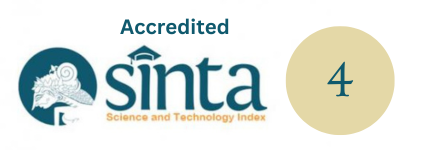SAMIRATA a Musical Art Composition Creative Percussion | SAMIRATA Sebuah Komposisi Seni Karawitan Tabuh Kreasi
DOI:
https://doi.org/10.59997/jurnalsenikarawitan.v1i3.355Keywords:
Keywords: Samirata, Gong Kebyar, Ubit-ubitan, Equation.Abstract
Abstract
The creation of this final percussion is starting to decrease, especially in Buleleng. In the past five (5) years, there has been no creative percussion in the form of a game pattern that focuses on the melodic processing approach, but the packaging or presentation of creative percussion works tends to use a rhythmic working approach. From the differences above, the stylist wants to create a more dynamic musical composition work. The medium expressed in this creative musical composition is the North Balinese style barungan gong kebyar (pacekan). From this, ideas emerged in the stylist to create a creative percussion composition entitled "Samirata". "Samirata" can be divided into 2 words namely sami and rata. Sami which means all while flat which means the same high / low surface that covers all parts and gets the same amount. So, Samirata means something that is indicated by the same thing without any difference in number, in the whole part. The stylist imagines by systematically arranging a composition whose source of inspiration is from the similarities in various types of ornamentation in the techniques of ubitan gangsa maker, gangsa kantilan, reong with other instruments.
Keywords: Samirata, Gong Kebyar, Ubit-ubitan, Equation.
Downloads
References
Anandakusuma, S. R. (1986). Kamus Bahasa Bali. CV Kayumas Agung.
Bandem, I. M. (2003). Gamelan Bali Di Atas Panggung Sejarah. BP Stikom Bali.
Dewantara1, I. P. G. E. P., Suartaya3, K., & I Ketut Garwa. (2021). Ghurnita. 01(01), 47–55. https://doi.org/10.25124/ghurnita.v1i1.212
Djelantik. (1999). Estetika Sebuah Pengantar. Masyarakat Seni Pertunjukan Indonesia.
I Kadek Tunas Sanjaya, I. N. K. (2021). Ghurnita. 01(01), 11–19. https://doi.org/10.25124/ghurnita.v1i1.141
I Putu Danika Pryatna, H. S. (2020). Konsep Musikal Instrumen kendang Dalam Gamelang Gong Kebyar Bali. 21(2), 73–84. https://journal.isi.ac.id/index.php/resital/article/view/4220
Ketut, A. P. I., Komang, S. I., & Hendra, S. (2020). Gending Sekatian Desa Adat Tejakula. JOMSTI, Journal of Music Science, Technology, and Industry, 4(1), 51–68. http://repo.isi-dps.ac.id/id/eprint/3789
Muryana, I. K., Haryanto, T., Gede, I., & Widi, F. (2020). Eksistensi Gamelan Gong Luang Di Banjar Seseh Desa Singapadu. 6(November), 105–110.
Prabawa1, I. K. A. A., & I Ketut Partha. (2021). Ghurnita. 01(01), 56–64. https://doi.org/10.25124/ghurnita.v1i1.217
Putra, I. K. A., Santosa, H., & Sudirga, I. K. (2020). The Concept of Balance at Sekati Ririg Gending in Tejakula , Buleleng Regency. HARMONIA Jurnal Arts Of Research and Education, 20(2), 183–194. https://doi.org/10.15294/harmonia.v20i2.25412
S., I. W. R. (2001). Gong Antologi Pemikiran. Balimangsi Foundation, Institut Seni Indonesia Denpasar.
Santosa, H. S. (2016). Gamelan Sistem Sepuluh Nada dalam Satu Gembyang untuk Olah Kreativitas Karawitan Bali. Pantun, 1(2), 85–96. https://jurnal.isbi.ac.id/index.php/pantun/article/view/747
Sukarta1, A. G., & I Ketut Muryana2. (2021). Ghurnita. 01(01), 29–36. https://doi.org/10.25124/ghurnita.v1i1.150
Yudha, I. N., Widiantara, P., Santosa, H., & Suartaya, K. (2020). Proses Penciptaan Komposisi Karawitan Kreasi Baru Paras Paros. 8(April), 1–13. http://journal.isi.ac.id/index.php/promusika/article/view/3607/2095
Yuniar, T. (1987). Kamus Lengkap Bahasa Indonesia. Agung Media Mulya.








